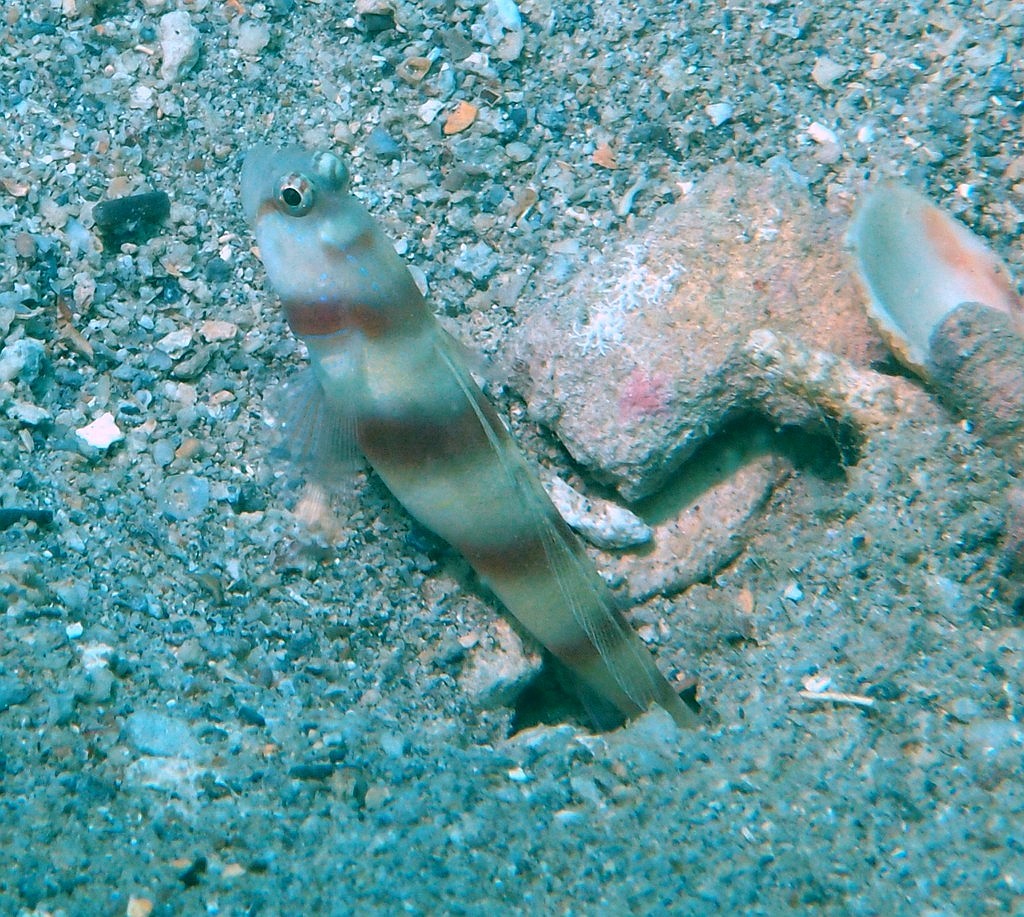AMBLYELEOTRIS STEINITZI - (KLAUSEWITZ, 1974)
Actinopterygii (Gigaclass) > Actinopteri (Class) > Teleostei (Subclass) > Gobiiformes (Order) > Gobioidei (Suborder) > Gobiidae (Family) > Gobiinae (Subfamily) > Amblyeleotris (Genus)
Steinitz' prawn-goby, Steinitz' shrimp goby, Steinitz's shrimp-goby, Steinitz´ Partnergrundel, gobie de Steinitz, gobie commensal
Description
Le gobie de Steinitz a le corps fuselé qui se rétrécisse vers la queue. Il est de couleur beige et strié légèrement en diagonale de 5 larges bandes marron. Ses yeux prohéminants cerclés de blanc et de noir sont situés très haut sur la tête. Les nageoires sont à peine visibles sauf les pectorales. Taille adulte 7 - 8 cm - Taille maximum 13 cm. Profondeur 5 - 30 m.
Biologie
La famille des gobies est la plus grande des poissons marins avec plus de 1.500 espèces. La plupart sont benthiques et vivent dans un terrier creusé dans le sable, en couple ou parfois en association avec une crevette qui entretien la galerie. Le gobie signale l'arrivée de prédateurs éventuels protégeant ainsi la crevette. Amblyeleotris steinitzi vit en association symbiotique avec des crevettes de la famille des Alpheidae (environ 600 espèces) en partageant son terrier. En mer rouge l'Amblyeleotris sungami ressemble à Amblyeleotris steinitzi.
Distribution
Indo-Pacifique Ouest de la mer Rouge à la Papouasie. Présent en Nouvelle-Calédonie.
Synonyme
Cryptocentrus steinitzi (Klausewitz, 1974)
---------------------------------------------
Description
Dorsal spines (total): 7; Dorsal soft rays (total): 12; Anal spines: 1; Anal soft rays: 12. Differs from Amblyeleotris wheeleri by having dull brown bars and more lateral scale rows. Characterized by yellow-white body color with five brown bars on head and body; usually with narrow orange bars on lower half of side in between each brown bar; dorsal fins with tiny yellow spots; pelvic fins basally joined by membranes; head and midline of nape without scales; longitudinal scale series 72-78; greatest depth of body 4.3-5.5 in SL; rounded caudal fin, slightly longer than head. Max length : 13.0 cm. Depth range 2 - 43 m.
Etymology
Amblyeleotris: from Greek, amblys or amblus = dull (blade: not sharp), blunt, obtuse + from the Greek name of a fish, eleōtris, found in the swampy waters of the Nile (Egypt) (from the Greek, eleios = who lives in the marshes). The name Eleotris appears for the first time in Déipnosophistes, a compilation of anecdotes and quotations from ancient authors, written by a scholar and grammarian Greek, Athenaeus of Naucratis (about 170-223 AD). In 1763, the Dutch naturalist and collector Laurentius Theodorus Gronovius (1730-1777) used this name to designate a new genus of fish. The authorship of the genre escapes him because his work was rejected by the scientific community of the time. The genre should have returned to the doctor, entomologist and naturalist of Italian culture, Giovanni Antonio Scopoli (1723-1788) but the late recognition of his work made him lose the authorship of the name. Today the genus, Eleotris, is attributed to Bloch & Schneider, 1801.
Distribution
Indo-Pacific: Red Sea to Samoa, north to the Yaeyama Islands, south to the Great Barrier Reef; throughout Micronesia. Also reported in New Caledonia.
Biology
Inhabits sandy areas of outer lagoon and seaward reefs. Lives with a pale brown or marbled brown and white alpheid shrimp. Found in coastal sand slopes and estuaries and usually at modrate depth of about 20 meters on deeper slopes.
